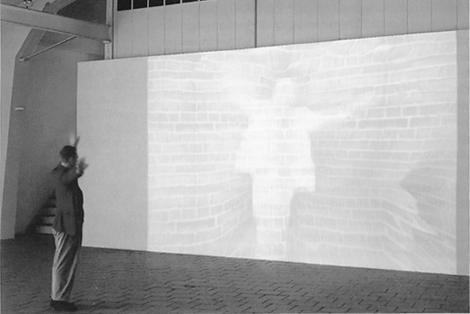
Peter Weibel

I. (Aristotle, or the World as a Stage)One plays the role of an outside observer in the realistic and objective model of the world. He is a spectator who does not have a say in the plot. He sees the world as a play. For him, the present laws of nature lead and direct the state of things and the turning of the world. God is the mighty master of time and the world is the clockwork created by him, since it has already been put in motion, it is working eternally according to the same laws, therefore it is not influenced by the subjectivity of man. In the classical theatrical model of the world, the observer sits in the audience and watches a world where things happen without him. This model, the one which says that our observation does not influence the turning of the world, is the basis of the classical mechanistic world concept.
II. (Plato, or the World as a Cave)We see only the reflection of things in the idealistic model of the world. The inversion of the realistic model progresses. The stage turns into a cave, where we sit, and from which we can see on the wall of the cave only the reflection of the world in front of it. What the world is like really, what the "being-in-themselves" things are like (Kant), all these are out of our experience and judgments. In the cave model of the world, we the human observers sit inside and look at a world, which is not directly accessible to us, where things happen without us.
III. (Curtain model, or the World as a Point of Intersection)Initially quantum physics inquired into the possibility of influencing the things happening on the world stage with the help of determining the observation and the role of the spectator (N. Bohr), and in this way it established a non-classical, so called, "participating" world and reality model (J.A. Wheeler). In the non-classical concept of our relation to reality, the stage is similar to a cave, but we ourselves are the curtains . The endo-physical interpretation of quantum physics (O. E. Rossler) shows that the world has no outside observation point, as is presumed by classical physics, but we are continuously observing the world from within. We live in a world that we observe and describe continuously. We are part of our own observations. Therefore, we are incapable of seeing the world from the outside objectively, and we cannot be independent of our models. The world is the world of the inside observer (cave), and at the same time the world is not situated outside our observation point (stage). If the objective outside world reflects on the wall of the cave, and we spectators are there as well, then we are also the wall. Quantum mechanic and endo-physics teach us that the observer is part of what he observes, meaning that he is part of the screen, i.e. the wall, on which reality also appears as the process of observation. So the world is the observation-relative. We are part of the world we observe and which we, through this observation, see only distortedly. The world is accessible only through our observation, which is the curtain between us and the world. Today we call this curtain the point of intersection. The world as the point of intersection therefore means that the so-called objective reality is the inner part of an outside world, the part which for the observer can only be accessible from the inside, and which he is only capable of seeing. Hence we have a new world concept, the curtain model, or the intersection model. In this non-classical world concept, the observer is not only the spectator but also the actor on the world stage.
IV. (The Wall: Lascaux)
"No one here gets out alive" - Jim MorrisonPresumably cave drawings could have been the basis of Plato's cave metaphoric. I have stored the image of a brick wall in the computer, which will be projected on the wall of the museum with the help of a data processor. If an observer stands in front of the wall, the videocamera records him. The computer transforms analogue signals recorded by the videocamera into lines of drawings, which influence the digital sign sequence of the brick wall, which has been stored in the computer. The modification of signs, which becomes sketchy and drag on due to the complexity of data processing, will be projected onto the wall. The spectator stands in front of the wall in reality, but virtually behind the wall. He stands simultaneously in front of and behind the wall, the stage, and the curtain. He is woven into the curtain and he draws himself into the cave drawings. So the observer is part of the world he sees, therefore part of the point of intersection, the inner side of the world. He is a captive of the world, though he is condemned to be only able to observe the world from within, therefore virtually he becomes the outside observer as well. With the help of new technology and new world concepts, he can transform himself into an outside observer of the world who is pushed to the wall of the cave from the outside. The citizen of the world becomes the fictive outside observer of the world in which he lives. This inner situation presses the spectator, the captive of the world, beyond the boundaries, the point of intersection and the wall to the prison bars of the space-time, the curtain of the stage and the wall of the cave. |